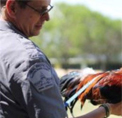
March 2020 by Mark Sloat, Christina Snow and Mike Wheeler
Audience: Executive Leadership, Shelter/Rescue Staff & Volunteers, Veterinary Team
Video Length: 50:20
When should animal control officers bring animals into the shelter? How do you prioritize calls when you get jammed? What role can returning animals in the field play in your organization's drive to save lives? Learn policies and procedures to implement in your organization and take the guesswork out of bringing animals in and streamline and prioritize the safety and wellness of pets and people.
This presentation was recorded at the 2020 American Pets Alive conference.

About Mark Sloat
Mark's career began in animal welfare in 1985 with the operation of a small non-profit rural dog rescue that he oversaw for 24 years. He also worked as a contract Animal Control Officer for a rural county in Minnesota for 11 of those years. During that time, he learned the value of returning pets to their families. While it made sense economically for the animal control contract, he quickly realized how valuable it was to the residents and their pets. By keeping them together, he was able to help the owners better care for and appreciate their pets. Mark has been employed by Austin Animal Services for 5 years starting as ACO in the Animal Protection unit, moving up to his current position as Program Manager.

About Christina Snow
Christina serves as the Animal Protection Manager for Pima County in Tucson, Arizona. Christina oversees 19 Animal Protection Officers; receiving 20,000 calls for service covering over 9,000 square miles. Prior to her work in Pima County, Christina was a Field Training Officer for Austin Animal Protection.

About Mike Wheeler
Over the last 10 years, Mike has been dedicated to animal welfare and public safety while reducing euthanasia and promoting responsible pet ownership laws in Cabot, Arkansas. Under Mike's management, the city-operated, open-admission shelter takes in over 3,000 animals a year with a 2019 Live Release rate of 99%. His passion for animal welfare and public policy extends to his position of President of the Arkansas State Animal Control Association.